Acne Face Map: What Spots in Different Areas Mean
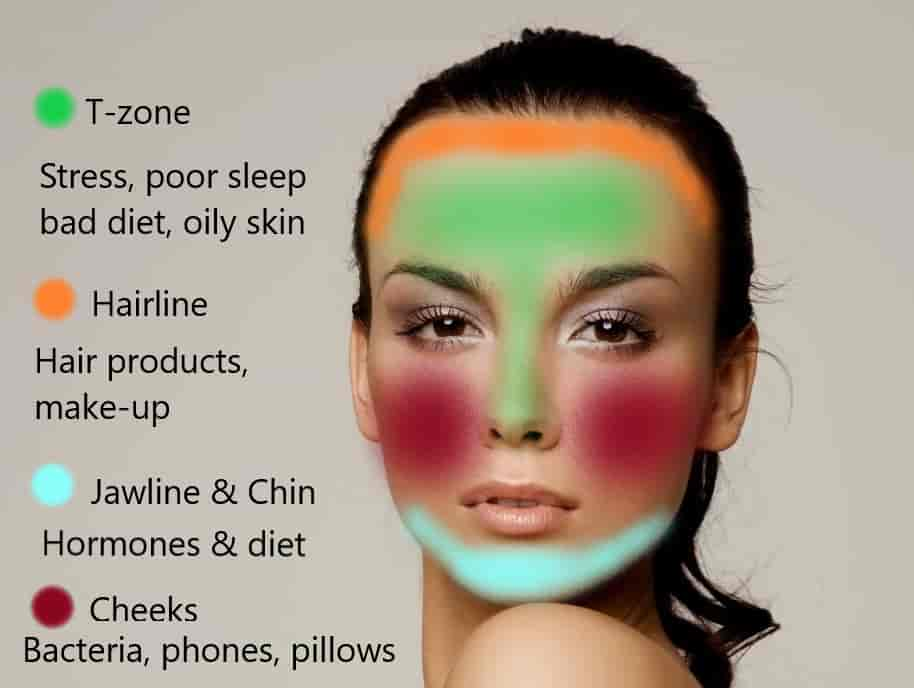
Content by

Last Updated
Explore our range of prescription acne treatments
Buy acne treatment online from a UK registered pharmacy
Table of Contents
- What Causes Acne?
- Decoding Your Acne Face Map
- Different Types of Acne
- What is The Best Acne Treatment?
- What Does Acne on Different Parts of Your Face Mean
A breakout of acne that develops on different parts of your face can tell you more about your health. Below is a series of acne face maps which provide more information about what acne can mean on different areas of your face. These findings are based on Ancient Chinese medicine and Ayurveda (holistic healing science originating from India 5,000 years ago).
What Causes Acne?
The skin on our body has very tiny holes. These tiny holes are called hair follicles and are often referred to as pores. Pores are connected to the sebaceous gland which produces an oily substance called sebum. If the pore produces too much sebum or the pore becomes clogged with dead skin cells, oil or bacteria, they produce spots or pimples. When these spots or pimples reoccur, this is known as acne.
Decoding Your Acne Face Map
Those that suffer with acne generally suffer most with face & body acne, with back acne another common form of acne. Acne on the face can be quite distressing and can at times be concentrated to a certain area of the face. Whilst there is limited scientific evidence connecting acne in an area of the face to health issues affecting organs in the body, there is some research that relates certain factors to acne on certain areas on the face.
Hairline
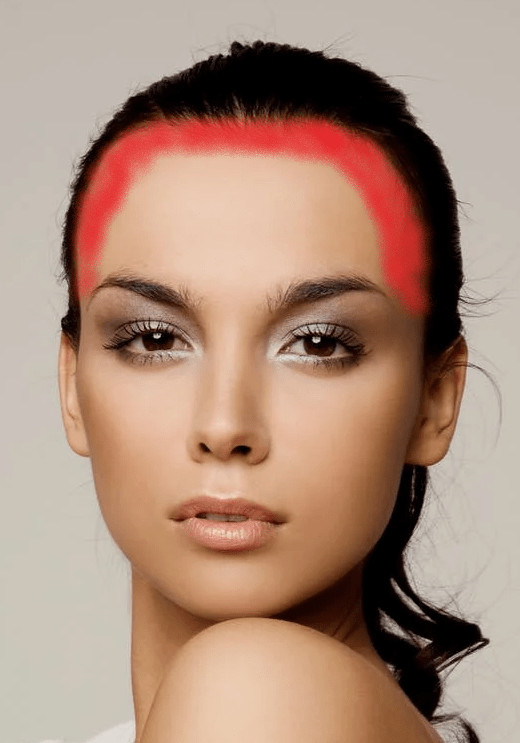
Acne that develops in the hairline can be down to the natural oil caused by hair or from using certain hair care products. Hair products that contain an increased amount of oil can cause excess oil to accumulate in the hairline. When acne forms around the hairline it is called pomade acne. Makeup can also cause oil to accumulate by clogging pores.
Tips to reduce hairline acne:
- Use simple and natural shampoos that do not contain allergens such as colouring, oil-based ingredients etc.
- Cover your hairline with a cloth when using hair products such as hairsprays or dry shampoo
- Try to use as little make-up as possible around this area
Cheeks
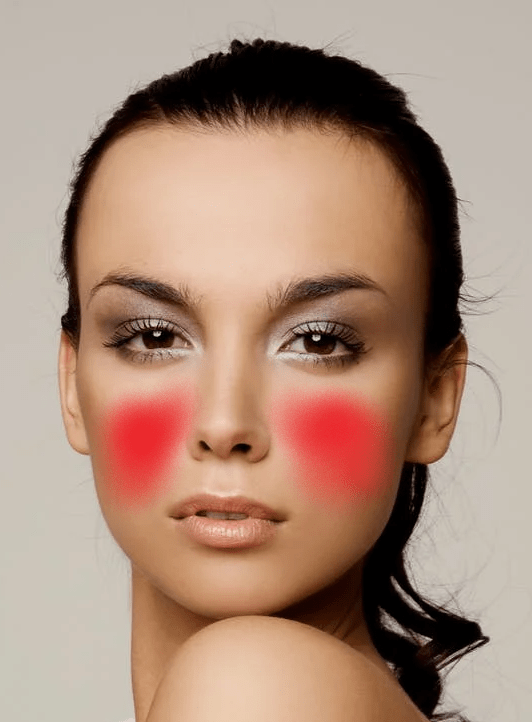
Acne on the cheeks can be caused by friction or rubbing of the skin. Frequently touching or rubbing your face can result in a spread of bacteria from your hands to your face. Holding your phone to your face or sleeping on dirty pillowcases can also result in the same spread of bacteria.
Tips for reducing cheek acne spots include:
- Wipe your smartphone every so often with antibacterial wipes
- Change your pillowcase every few days
Jawline and Chin
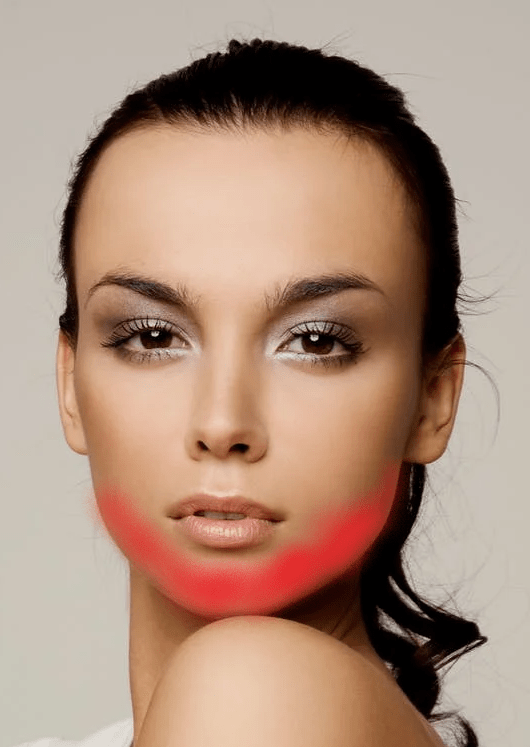
Scientists are split on the view of whether acne on your jawline and chin are caused by a fluctuation in hormones. Factors such as hormones and stress are known to increase oil production, and this in turn can cause clogged pores and acne. Some women experience an increase in acne breakouts during their menstrual cycle or pregnancy and NHS England suggest this could be caused by hormonal changes that occur during this time. Research suggests that up to 85% of women find that their acne is worse in the days leading up to their period. Conditions such as PCOS (polycystic ovary syndrome) can also continue to acne as a result of hormonal fluctuations. Research suggests that your diet can have an effect on hormone levels. Foods that contain dairy products can affect hormone balances.
Tips for reducing acne round the chin and jawline:
- Drink as much water as possible
- Keep your diet low in sugar, oily food and dairy products
Nose and forehead (T-zone)
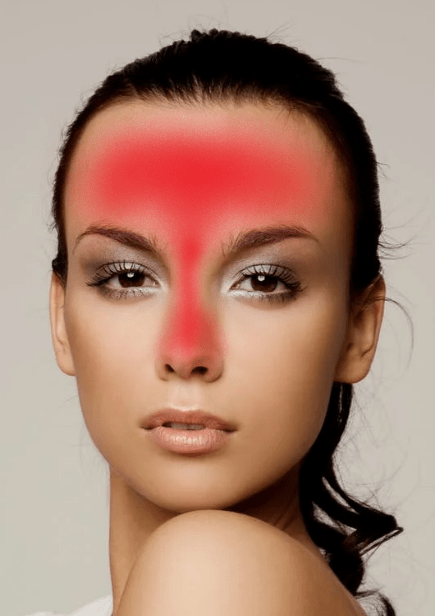
The nose and forehead area are known as the T-zone area. Causes of acne in the T-zone are due to sebaceous glands producing excess sebum. Lack of sleep and stress can contribute to acne around the T-zone area. Naturally oily or dry skin can also cause spots and pimples around this area. Pollution in the air is also thought to play a part in causing acne around this area.
Tips for reducing acne around the T-zone:
- Practise good sleep hygiene
- Stress less! Meditating and taking control of your mind may help in reducing acne
- Use gentle and mild cleansers for oily skin if you have an oily skin type
It's important to note that acne is not only experienced by teenagers but adults are also susceptible to acne, often referred to as 'adult acne'.
Different Types of Acne
There are 6 common forms in which acne can appear:
Whiteheads
Whiteheads form when the sebum from the pore mixes with bacteria and dead skin cells. Whiteheads occur just under the surface of the skin, which is why they appear white.
Blackheads
Blackheads appear on the surface of the skin when pores are clogged with bacteria and dead skin cells and tend to be either black or yellow in colour. The colour does not signify dirt and is caused by the sebum oxidising at the surface of the skin.
Papules
Papules are inflamed red bumps that can be sensitive or sore to touch.
Pustules
Pustules are similar to papules, but they are also puss-filled and have a white or yellow tip in the centre.
Nodules
Nodules are a more severe form of acne and present as large hard lumps underneath the surface of the skin. They do not generally contain pus and can be painful.
Cysts
Cysts are the most severe form of acne. They are large inflamed lumps filled with pus. Cysts are also painful and can at times require medical treatment.
What is The Best Acne Treatment?
Treatment can vary depending on the type of acne and how severe the acne is. It can sometimes take several months for acne to improve once treatment has started. For moderate to severe acne the following topical treatments are effective methods to help clear acne:
Acnecide
Acnecide gel / Acnecide Wash contain the active ingredient benzoyl peroxide which works to reduce the amount of bacteria on the skin. Acnecide also thins the area of skin where it is applied which loosens up the area and allows it to shed. Acnecide can be used on mild acne and is effective on inflammatory acne such as pustules and papules. This can so be used on blackheads and whiteheads. Acnecide is considered a first-line treatment.
Differin Gel
Differin contains an active ingredient called adapalene, which is a retinoid. Retinoid is a class of medicine which is derived from vitamin A. Retinoid works by encouraging skin cell turnover, preventing pores from getting clogged. Differin is mainly used to treat acne which is on the surface of the skin, such as whiteheads and blackheads. Differin is also a prescription only medication.
Duac Gel
Duac gel contains benzoyl peroxide and an antibiotic, clindamycin. Benzoyl peroxide reduces the amount of bacteria on the skin, whilst clindamycin creates an unfriendly environment for bacteria to survive in. Duac is best for mild to moderate acne as it helps reduce swelling and is a prescription only medication.
Epiduo Gel
Epiduo contains adapalene and benzoyl peroxide. The combined ingredients prevent acne and reduce skin inflammation. Epiduo is mainly used to treat mild to moderate acne and works well on whiteheads and blackheads.
Treclin Gel
Treclin contains two active ingredients, clindamycin and tretinoin. Tretinoin promotes cell production which prevents pores from getting clogged. Treclin can be used to treat whiteheads, blackheads, pustules, papules and redness. Treclin is a prescription only medication.
Zineryt
Zineryt contains an antibiotic, erythromycin and zinc. These two ingredients work to reduce the growth of bacteria, production of oil and reduces inflammation. Zineryt works well with moderate to severe acne. The effectiveness of erythromycin has declined in recent years, and this treatment is usually reserved for those who have not had a positive result with all other treatments.
A doctor may prescribe certain types of the contraceptive pill (birth control pills) for female patients. Co-Cyprindiol and Dianette are popular contraceptive pills that double up as acne treatments.
What Does Acne on Different Parts of Your Face Mean
Acne in different parts of your face can tell you a little more about your body and your lifestyle. Although scientific research around this area is limited, acne face mapping can help as a starting point. It is worth making changes to your sleeping and eating habits, as well as your skincare routine.
Whilst all of our content is written and reviewed by healthcare professionals, it is not intended to be substituted for or used as medical advice. If you have any questions or concerns about your health, please speak to your doctor.
